by Lee Orloff, CAS
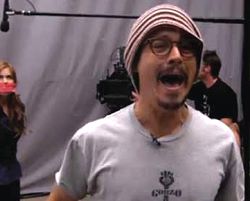
I’ve heard it said that the two happiest days in a film person’s life are the day when we hear that we got the job and the day we hear the final “wrap” called. Rango was the exception; it was deeply satisfying to be working within a medium that had been only familiar to me from afar, yet applying a novel and unique approach to the process. While we were making it, we were all hoping to hear that a sequel was in the works.
I remember the first day the filmmakers invited me and a few other department heads over to their office to discuss the project and toss around some ideas. Gore Verbinski, the director with whom I had collaborated on six previous films, among them the first three in the Pirates of the Caribbean series, had been working on an animated feature for quite some time and was now ready to go into production. He wanted me to mix it. I immediately thought of cracking out a vintage big-diaphragm Neumann, as in the past for Nic Cage’s inner monolog on The Weather Man or other voiceovers. My instincts told me to double track the actors on a trusty U87 (or the like) along with my favorite choice of boom mike. However, as the meeting progressed, the project was gradually brought into sharper focus. Wait a second … they said this was an animated feature. What exactly did going into production mean?
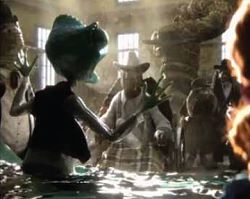
We were to comprise an Emotion Capture Unit, a relatively lean unit of 85 or so of us, brought together for 22 days on Universal’s Stage 42 to record all of the cast performances as an ensemble in a comfortable and flexible setting. This would facilitate more spontaneous and natural performances than would have otherwise been possible if the production had been done using more traditional methods. It was to be shot as live action, though more akin to a motion-capture production. However, since nearly all the characters were to be rendered in non-human form, there was no need to utilize all of the motion-capture technology that we had used on past productions. One of the unique benefits of covering the action with three high-def cameras on an expansive soundstage was that it provided the animators not only with the actors’ facial expressions as reference, but all of the spatial relationship and blocking as well. The sets were largely “virtual” in nature, but there were significant elements such as a long oak bar, saloon doors, a wagon, or the mayor’s desk and wheelchair that the cast needed to play the scene. The set was neutral and evenly lit to provide consistent visual reference. The production’s expectation from the Sound Department was a tad more stringent, but also crystal clear: deliver the highest quality production track as the basis of the entire dialog recording for the film.
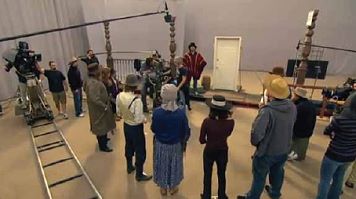
worked for all concerned parties.The shooting area was contained within a space delineated by neutral gray solids suspended most of the way from the perms to the floor. To achieve flat, even lighting throughout, coops were evenly spaced above. To eliminate footfalls we carpeted the entire area. We installed bafflesin the perms between the lighting instruments to dampen sound reflections that might otherwise spill over the grey solids. The construction department built us portable baffles and boxed out and vented the transformers on the rear end of the stage to lower the ambient noise floor.
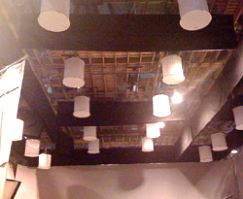
Finally, the last project was to create a smaller, more intimate space where we could shoot additional “coverage” of larger scenes or shoot smaller scenes in their entirety. We wanted the smaller space to be equally flexible but a more controllable environment. I found that Universal had portable sound walls in storage that they had utilized to block the sound of outdoor events. These heavy baffles, covered by “Insul-Quilt”-type material, were suspended from the perms to create three sides of the space, with the fourth being left open for versatility. Normally, we would simply draw the rest of the solids across the opening and close off the space. For wider shots, the open side could be used to place cameras. In these instances, we would place our baffles behind the cameras as a fourth wall.
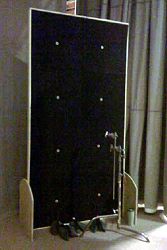
Boom microphones were used exclusively to capture the ensemble cast performance with the fullest, richest quality. You heard that right. Leave the wireless mikes back at the shop; an entire production accomplished without tagging a single actor. Due to the size of the cast and the impromptu nature of the blocking, three boom operators were needed. Jeffrey Humphreys, Brian Robinson and Mike Anderson handled the responsibilities with creativity, the utmost professionalism, and most importantly, great attitudes. Initially, I considered bringing the Sennheiser boom mikes directly into the Aaton Cantar and mixing with the Cantarem remote faders. The added flexibility of a Sonosax SX cart-based setup won out. I paired this to a Sound Devices unit doing backup duties onto CF cards that we shuttled to editorial. We used Sony F900s, synched to Lockit boxes and quieted down with barneys. The Prop Department worked with us to silence their objects as required. Video Village contained a specially constructed desk on wheels, more along the lines of a portable lectern, which contained an iMac, small Yamaha mixer, headphone distro amp, a passel of Sony MDRs and my Dynaudio near-field monitors for referencing playback as well as the video storyboard and other edited material. Our supervising sound editor, Peter Miller, made available some elements Gore wanted for playback to enhance the onset experience for the cast. On The Ring, there was an effect called “whisper keening” that we used repeatedly as a cue with the TV set. This time around we had church bells and assorted other sounds, as well as music cues, which were handled with my Steinberg Cubase–equipped laptop through a Sound Devices USBPre into a Crown amp and a pair of Technomad cabinets.
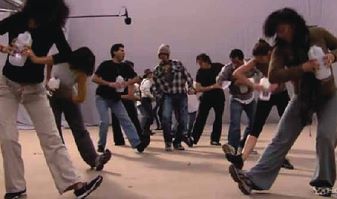
Now, it was time to assemble the concerned parties on the dub stage to listen to tracks and see whether we were all on the same page. With the gracious participation of Jon Taylor at Universal who opened up the stage to the director, producers, editor, and the studio post-production folks, we auditioned material from both the shooting areas. All agreed that we had acceptably knocked down the reflections of the empty stage, and that the quality of the recorded vocal tracks would nicely do the trick.
Imagine going to work on Day One and finding that customary walkie chatter was not about getting the cast off the stage after rehearsal and through the works, final touches and so on, but rather when they’d arrive at stage. Period. When they arrived they might don a hat, slip on an article of clothing, or prop themselves up to further get into character, but that was about it before we’d hit the lights and bell and off we’d go. Then doing far more 20-minute takes than not. Five weeks with the cross hairs aimed precisely at the same point. There were no little breaks like leisurely trips to graze at crafty or walking off stage for better cell reception during re-sets. One day I’m across in the men’s room and the PA comes running in, “They’re all waiting for you to roll.” I was mixing a show where, once the director had the take he was looking for, his only technical consideration was, “Was everything good for Sound?” One of the great things about working with Gore Verbinski, who happens to be a gifted musician among his other strengths, is that he happens to have an excellent “ear.” He is tuned in to the slightest details. Conversations about enunciation, separation, head turns and chin downs, a level that might have gotten “spicy” in his words, have been commonplace over the years. This time, that focus was probably multiplied five or tenfold which was a good thing for all of us in the department. It brought out the best in all of us, and it was a nice boost to the department’s pride, knowing that the attention to detail we all strive to provide on any show was truly understood and appreciated on Rango.